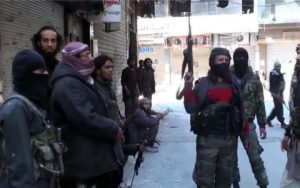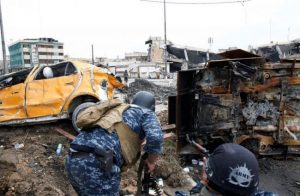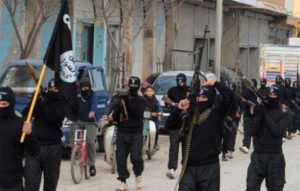U.S. Special Operations Forces’ changing mission in the Middle East
Despite former President Barack Obama’s efforts to cut U.S. military commitments in the Middle East, events quickly drew his Administration back into the region. Civil war in Syria, Libya, Yemen, and, particularly, ISIS’s 2014 expansion into Iraq combined to keep Washington militarily involved the region, like reported by thecipherbrief.com .
The nature of this involvement has changed significantly, though. Rather than commit regular troops, the U.S. has increasingly relied on elite special operations forces (SOF) to accomplish its goals. In Syria alone, SOF deployments have grown steadily from roughly 300 in early 2016 to over 700 today, and reports suggest further increases as the Trump Administration ramps up its anti-ISIS strategy.
Special operations forces offer policymakers flexible, effective, and discreet ways to deal with the region’s complex conflicts, but many worry that overreliance on SOF could undermine readiness. How has the role and tempo of operations for SOF in the Middle East changed and what measures, if any, will President Donald Trump take to relieve some of the stress placed on U.S. special operations forces deployed to the region?
At any given time, there are roughly 8,000 SOF soldiers stationed in over 80 countries and, according to General Raymond Thomas, commander of the U.S. Special Operations Command, the role these forces are asked to play is quickly evolving. Thomas told the House Armed Services Committee last week that SOF are no longer a “mere ‘break-glass-in-case-of-war’ force, we are now proactively engaged across the battle space.”
Nowhere is this more true than in the Middle East, where SOF are at the cutting edge of an anti-ISIS strategy that relies heavily on training, supporting, fielding, and coordinating local allied forces. This focus on “building partner capacity” to conduct counterterrorism and counterinsurgency missions is well within SOF abilities, and has been a linchpin of U.S. national security strategy since 9/11. However, ISIS’s rise in Iraq and Syria, combined with deep political resistance to committing U.S. conventional ground forces to the conflict, has concentrated the efforts of the anti-ISIS coalition on training and supporting effective local partners, such as state-level armed forces or allied insurgents.
Linda Robinson, a senior international policy analyst at the RAND Corporation, points to the use by General Joseph Votel, commander of U.S. Central Command (CENTCOM), of the Special Forces phrase “by, with, and through” as good way to think about this new focus; in essence, U.S. SOF are becoming more deeply embedded with local allies to defeat ISIS by, with, and through these local partners. Because the counter-ISIS coalition is so diverse –from conventional armed forces in Iraq to Sunni Arab rebels and Kurdish militia in Syria – the demand for SOF has skyrocketed, and SOF soldiers are being pushed into expansive new roles that include not only training and advising local partners, but also coordinating U.S. and coalition fire support, and managing relations between coalition partners.
“If they succeed in ousting ISIS from Mosul and Raqqa in the coming months,” says Robinson, “this new way of combining forces and using SOF to direct a ground war could become a model for conducting low- to mid-level combat.”
However, this model also places a heavy strain on special operations forces. First, heavy and increasing demand for these forces by CENTCOM in the Middle East will likely increase the tempo of deployments to the region, which would be stressful for SOF members and their families and could sap resources from other geographic combatant commands. According to General Russell Howard, former commander of the 1st Special Forces Group, this happened during the height of the wars in Iraq and Afghanistan when “nearly 80 percent of the [special operations] force was deployed in the MENA [Middle East and North Africa] region and Afghanistan.”
Nowhere near that proportion is concentrated in the region now, but the number and diversity of missions that SOF deployed to the Middle East are now asked to complete also presents what Howard calls “a huge training challenge.” In the past, Special Forces soldiers could generally focus more finely on one type of mission such as foreign internal defense, which is aimed at training foreign militaries. Today, though, says Howard, those soldiers might be expected to engage in “unconventional warfare [assisting insurgents against a state], counterterrorism, foreign internal defense, or counterinsurgency…all in the same day.”
Fortunately, this is a challenge that SOF are flexible enough to overcome, and that is why they have become the force of choice for this kind of warfare. However, this reliance has caused some military planners to worry that, as Acting Assistant Secretary of Defense Theresa Whelan recently testified to Congress, “we have had to eat our young … [and] mortgaged the future in order to facilitate current operations.”
There are signs that the Trump Administration is beginning to shift some of the SOF mission in the Middle East to conventional troops. The White House has stopped disclosing troop deployments, but in March, the Pentagon sent roughly 400 Marines to Syria and 300 paratroopers from the 82nd Airborne Division to Mosul, as well as new artillery and air fire support assets. Nevertheless, unless the Administration decides to either commit a large number of conventional troops or abandon the recent gains made against ISIS in Iraq and Syria, SOF will continue to be the indispensable force for Trump’s military goals in the region.
Up to 5,000 Chinese Uighurs joined militant groups in Syria
Malaysia’s top Islamic State operative killed in Syria
Muhammad Wanndy Mohamed Jedi, 26, who was on a US list of global militants, was the alleged mastermind behind a grenade attack on a Kuala Lumpur bar last June which injured eight people. It was the first and so far only Islamic State attack that caused casualties in Malaysia.
Police had earlier cast doubt on the reports, saying that it was possible Muhammad Wanndy had faked his own death.
Born and raised in the west Malaysian state of Malacca, Muhammad Wanndy left for Raqqa with his wife in 2014. He first drew public attention the following year when he appeared in a video showing the beheading of a Syrian man.
Using the name Abu Hamzah Al Fateh, he quickly made a name for himself as an Islamic State online recruiter and fundraiser.
Statistics from the police counter-terrorism unit show that at least a third of the more than 250 people arrested for Islamic State-linked activities in Malaysia between 2013 and 2016 were recruited by or linked to Muhammad Wanndy.
In March, he was named a “Specially Designated Global Terrorist” by the U.S. Treasury, making him a high-profile target for law enforcement agencies worldwide.
Syrian Islamic rebels begin to evacuate Damascus suburb
Hundreds of Syrian rebel fighters began a process of leaving the besieged Damascus suburb of Barzeh on Monday as part of an evacuation deal agreed with the government, state television and a war monitor reported.
State-run Ekhbariya television cited its reporter there as saying the evacuation of fighters from Barzeh for the rebel-held Idlib province in northwest Syria had begun to be implemented but without giving further details.
The Syrian Observatory for Human Rights, a Britain-based war monitor, reported that buses had arrived in Barzeh at dawn and a group of hundreds of fighters and their family members had started to board them.
The Observatory said more people would leave Barzeh over the coming days as part of the same deal. Barzeh is in northeast Damascus near the rebel-held Eastern Ghouta oasis district of towns and farms and has been the site of intense fighting between insurgents and the Syrian army in recent months. On Sunday, the army advanced under intense bombardment in the Qaboun district, which adjoins Barzeh in the same besieged enclave, the Observatory said.
A military media unit run by the armed Lebanese Shi’ite group Hezbollah, an ally of the Syrian government, reported on Monday that several Red Crescent ambulances had also arrived at the rebel-besieged towns of al-Foua and Kefraya near Idlib.
Those two towns were part of a mutual evacuation deal that also included two towns besieged by government forces and involved exchanging thousands of people between the warring sides last month. Syrian President Bashar al-Assad has promoted the use of such evacuations, along with what his government calls “reconciliation” deals for rebel-held areas that surrender to the government, as a way of reducing bloodshed.
However, the United Nations has criticised both the use of siege tactics which precede such deals and the evacuations themselves as amounting to forcible displacement. Many of those who have left other besieged areas of Syria have also relocated to Idlib, a mostly rural province abutting the Turkish border which is a major rebel stronghold.
Islamic State executes two members in Anbar for escaping Mosul battles
Islamic State members executed two comrades on Monday in Anbar province after they had escaped battles against Iraqi government forces in neighboring Mosul, like reported by iraqinews.com.
Aljournal news website quoted a security source saying that a firing squad shot the pair dead near a hospital in the city of Qaim, west of Anbar. The pair’s families were forced to move to Raqqa, the group’s main bastion in neighboring Syria, seizing their vehicles and residences, according to the source.
The source added that the group threatened to kill any member attempting to similarly escape from the group’s strongholds of Qaim, Rawa and Annah, the western Anbar towns which the group has held since 2014. They warned that the families of members who would attempt to escape would be denied movement and will have their cell phones and passports confiscated.
Last week, Alsumaria News reported that the Islamic State had issued arrest warrants for several members who had fled fighting against Iraqi troops in western Mosul to neighbouring Syria. It quoted sources saying that the group’s so-called “security department” in Nineveh ordered that those who return voluntarily to the battlefield shall receive 90 lashes and two months in jail, while those caught while at large should be executed.
Since Iraqi troops, backed by the U.S.-led coalition and paramilitary forces, launched a campaign in October to retake Mosul from the Islamic State, the group has been sustaining severe losses in terms of personnel and finances, with hundreds of senior leaders killed and others reported at large. The group has occasionally executed or levied harsh punishments on members for either attempting to escape or for slack performance on the battlefield.
Iraqi commanders have claimed control over 70 percent over western Mosul. Eastern Mosul was declared militants-free in January.
Libyan Islamic State leader killed in security offensive west of Mosul
A Libyan senior leader of the Islamic State was killed in western Mosul on Sunday as Iraqi security forces sweep through districts on a new axis of operations taken last week, according to iraqinews.com.
Federal Police chief, Lt. Gen. Shaker Jawdat, said Khaled ibn al-Waleed, a prominent IS leader, and five of his sentry, were killed when security troops pounded the group’s main police headquarter in the city.
He also said 40 IS members were killed in police bombardment on al-Zanjili district, and became close to the fifth of bridges linking western and eastern Mosul.
Jawdat added that other IS casualties fell down when a drone guided by militants mistakenly bombarded their gathering near the Grand Nuri Mosque in the Old City, an area besieged by the forces for weeks.
The developments come as Iraqi commanders say they recaptured Mesherfa and most of Haramat and 30 Tamuz (July 30th) districts which fall on the northwestern axis of operations, a new front which Iraqi forces resorted to having found it difficult to invade the Old City from the south.
Iraqi troops took over eastern Mosul from the Islamic State in January, and have been advancing through the west since mid February, recently claiming control over 70 percent of that region.
32 ISIS members killed in Tabqa amid ongoing fierce clashes
Clashes between Syrian Democratic Forces and ISIS continue in Tabqa town since last night and 32 ISIS members have been killed, like reported by anfenglish.com
Clashes between YPG-led Syrian Democratic Forces (SDF) and ISIS continue uninterrupted since 18:00 Saturday evening. Fighting that intensified in the neighborhoods of Hay Awwal and Hay Salis spread to the Tanî neighborhood late at night.
SDF fighters are acting with utmost attention for the security of civilians and due to the snipers of the gangs, and they are advancing and clearing the town house by house and street by street.
During clashes ongoing since last night, International Coalition aircraft conducted 8 strikes against the positions of the gangs in New Tabqa neighborhoods (Hay Awwal, Tanî and Salis).
32 ISIS members have been killed during the fighting since last night and one SDF fighter got injured.
In Saturday evening, 19 ISIS members including 4 snipers were killed and 2 SDF fighters were wounded. SDF fighters also seized ammunition from the gangs.
Fierce clashes continue in three neighborhoods of the town.
Islamic State issues arrest warrants for members fleeing Mosul to Syria
The Islamic State has issued arrest warrants for several members who had fled fighting against Iraqi troops in western Mosul to neighboring Syria, a local source was quoted saying according to iraqinews.com .
Alsumaria News quoted the source saying the group’s so-called “security department” in Nineveh ordered those who return voluntarily to the battlefield shall receive 90 lashes and two months in jail, while those caught while at large should be executed.
Most of the fugitives were from the group’s hideouts in the western Mosul districts of al-Arabi, al-Farouq and 17 Tamuz (July 17th), according to the source.
Many of the group’s non-Iraqi members returned home, with the flow of foreign fighters almost stopped, the source added.
Since Iraqi troops, backed by the U.S.-led coalition and paramilitary forces, launched a campaign in October to retake Mosul from the Islamic State, the group has been sustaining severe losses in terms of personnel and finances, with hundreds of senior leaders killed and others reported at large. The group has occasionally executed or levied harsh punishments on members for either attempting to escape or for slack performance on the battlefield.
Iraqi commanders have claimed control over 70 percent over western Mosul. Eastern Mosul was declared militants-free in January.
The Iraqi command opened earlier this week a new front for ground offensives targeting IS’s strategic stronghold at the Old City region from the north, having found it difficult to invade the area from the south for weeks.
Tabqa Operation: 52 ISIS members killed
52 ISIS members have been killed in clashes around Tabqa and the eastern villages, like reported by anfenglish.com
SDF’s operation to liberate the surroundings of Tabqa and the Euphrates Dam has entered day 45.
The clashes that broke out between SDF fighters and ISIS gangs in Sahl al-Xesheb village to the east of Tabqa have been going on for 4 days. Last night 2 gang members stepped on the mines laid by the fighters and both were killed. Sporadic clashes continue around the village.
In Safsafah and Abad villages 4 km to the east of the town, the operation launched after the fighters broke the attacks continues. In this operation, 40 ISIS members including 2 gang leaders were killed. 18 bodies, 4 BCKs, 14 Kalashnikovs and 60 rounds, 5 grenades, 1 pistol, 1 day vision binoculars, 1 Katyusha and 73 rockets, 1 DSHK, 1 mortar and 12 shells, large amounts of Kalashnikov, BCK and DHSK rounds have been seized by the SDF fighters.
In clashes in New Tabqa (Hay Awwal, Tanî and Salis) that continued from midnight to the early morning hours, 10 gang members were killed and some weapons and ammunition were seized. Intense clashes continue in the area as of now.
In the 3-day long clashes in Sahl al-Xesheb village and 3 neighborhoods of Tabqa, 76 gang members had been killed.
- « Previous Page
- 1
- …
- 98
- 99
- 100
- 101
- 102
- …
- 401
- Next Page »












